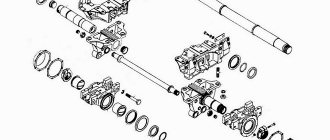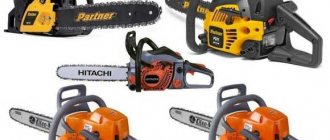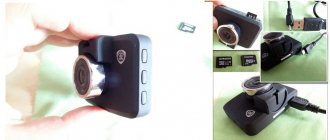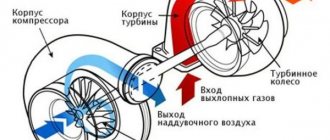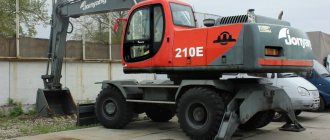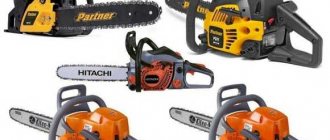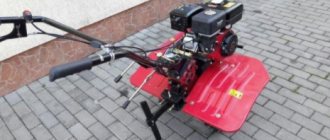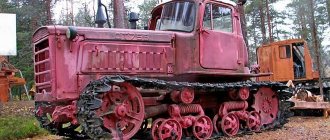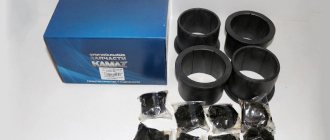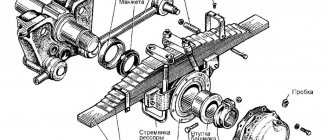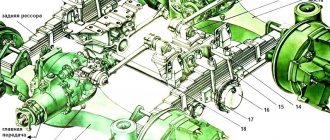| Applicability | KamAZ 6460 / 53228 / 65111 / 43501 / 63501 / 53504 / 43261 / 65115 / 43118 / 65116 / 53501 / 6450 / 4350 / 6350 |
| Outer diameter, mm | 100,5 |
| Inner diameter, mm | 88 + 0,4 |
| Material | Arkaim |
High strength characteristics
Strength and resistance to stress are higher than that of metals.
The cost is at the level of metal analogues or lower, and the service life is longer.
Low coefficient of friction
Friction coefficient for steel 0.1-0.2 without lubrication, 0.05 with lubrication
Bushing sizes
| vendor code | Dimensions (D1xD2xh) | Order separately |
| 55111-2918074-01Р0 | 88,2×100,5×2,5 | Order |
| 55111-2918074-01Р1А | 87,0×101,0×3,0 | Order |
| 55111-2918074-01Р2 | 86,0×101,0×3,0 | Order |
| 55111-2918074-01R1B | 87,0×106,0×3,5 | Order |
Shoe bushings 55111-2918074-01 (repair sizes) are used on KamAZ vehicles in the balancer shoe. The bushings act as bearings and are pressed inside the balancer. The products help to increase the operating life of components and assemblies, guarantee the reliability of their operation, and also minimize the possibility of emergency situations.
Products are made from polymer material and have a number of important qualities. Firstly, throughout their entire service life, polymer bushings require virtually no maintenance and can operate even without lubrication. Secondly, the bushings are resistant to temperature changes and have increased impact strength. In addition, bushings made from composite materials are cheaper and easier to manufacture.
ATTENTION!
The electronic catalog of spare parts intended for reference purposes only!
Our company does not sell all spare parts presented in this list. If there is a “Cost” link in the right column, these spare parts are on active sale. Availability in warehouses for details and prices, see the product card. If there is no “Cost” link in the right column, we do not sell such parts and do not accept orders for them.
Read also: Tomasetto Alaska pressure regulator
Modern Kama 3-axle trucks, 2-axle and 3-axle semi-trailers use a suspension, at the ends of which there are springs resting on the rear axles, and between them on the frame there is a balancing mechanism.
Purpose of KamAZ balancer:
- compensation of vertical loads;
- stabilization of lateral displacement;
- reduction of wear on the chassis system;
- maintaining stability.
Do-it-yourself maintenance of KamAZ balancer
Modern Kama 3-axle trucks, 2-axle and 3-axle semi-trailers use a suspension, at the ends of which there are springs resting on the rear axles, and between them on the frame there is a balancing mechanism.
Purpose of KamAZ balancer:
- compensation of vertical loads;
- stabilization of lateral displacement;
- reduction of wear on the chassis system;
- maintaining stability.
How the node works
The balancer device contains, depending on the design of the machine, 1 or 2 transverse axes:
- In a mechanism with 1 axle, the spring connection is reinforced with stepladders.
- With 2 axles, it is pressed into brackets connected with a tie and secured with studs to the rear suspension elements. The latter are connected to the welded frame side members with reinforced bolts.
At each free end of the axle there are shoes on springs. They fix the parts, have a plug hole through which oil is poured, and are equipped with seals:
- rubber cuffs prevent oil leakage;
- rings protect the inside from contamination.
A special bushing made of a material with a low friction coefficient and increased wear resistance is installed at the shoe attachment point. The manufacturer most often makes it from aluminum or bronze.
Modern trucks are equipped with bushings made of aluminum-zinc alloy or fluoroplastic.
The lubrication in the shoes is liquid or grease. When installing polymer bushings, a thick fill is used, which requires less maintenance.
Repair
During the operation of KamAZ, the balancer, despite the strength of the parts, wears out, which leads to breakdown of its components. Therefore, inspection and maintenance are carried out in a timely manner in specialized service centers or with your own hands.
Rear suspension repair involves diagnosing and replacing brackets and bushings due to emerging defects, such as:
At the same time, the condition of springs, reactive traction loads, stepladders, oil seals and shoes is checked.
Bushing wear is a common cause of balancer failure. The fit of the parts is periodically checked by tapping with a hammer. When loosened, the pins are replaced with new ones. Bushings are repaired when consumables wear up to 90.2 mm.
If there is an oil leak from the crankcase, replace the seals.
Repairing the balancer axis consists of eliminating traces of damage by grinding and installing repair elements reduced in internal dimensions.
How to adjust
Adjusting the axial clearance in the balancer shoe on a KamAZ vehicle is performed as follows:
- Place the machine on a stand.
- Pull the spring ends from the rear axle supports and remove the part, thereby ensuring the rotation of the balancer.
- Unscrew the split nut so that the mechanism cannot be turned by hand.
- Unscrew it 1/6 turn.
- Tighten the pinch bolt. The tightening torque should be 8-10 kgf*m.
- Check the rotation of the balancer. If they are difficult, loosen the pinch bolt and unscrew the nut.
Replacing bushings
As you drive, the wear rate increases. An increase in the space between the bushing and the axle affects the balancer, which swings in different planes and deforms the parts.
The standard axle diameter is 88 mm. For tight pressing, the outer dimensions of the balancer bushing are 100.2-100.3 mm, the inner dimensions are 1 mm less.
The nominal gap is 0.12-0.30 mm. Replacement of worn bushings is carried out when the critical value reaches 1 mm.
The balancer at the landing site can be ellipsoidal or conical. For alignment and reliability, it is better to press the bushings into the shoe, install them on a boring machine and bore 2 pieces at once. The calculated diameter of the sleeve should be 0.05-0.08 mm larger.
Do-it-yourself KAMAZ balancer repair
When repairing a KAMAZ balancer axle or repairing a KAMAZ balancer shoe, it should be taken into account that this axle has a nominal size of 8.8 cm, the shoe bushing is 8.75 cm, and the repair bushing is approximately 8.4 cm. The nominal size of the gap between the bushings and axle - from 0.12 to 0.305 mm, and the permissible maximum gap size between the bushings and the axle is 1 mm. If the bushings move freely, they must be replaced with new ones. We also need to replace the balancer cuff, boot, protective cup and nut, and inject the shoes using a grease fitting.
If cracks are detected in the spring sheets, they must be replaced with main sheets with a thickness of 12 mm (nominal) to 18 mm (maximum). It is recommended to measure the sheet size using a tape measure and caliper to provide the seller with accurate data. When assembling the springs, it is necessary to lubricate the rubbing leaf surfaces with graphite-based lubricant, and lubricate the pins on the front springs. Installation of rear and front springs on a car is carried out in pairs, the difference in deflection should not exceed 1 cm.
KAMAZ balancer axle diagram
Procedure for adjusting the axial clearance of the balancer shoe
- Lift the car by the frame, place it on stands, make it possible to rotate the balancer by separating the ends of the spring located at the rear from the bridge supports, or by removing the spring.
- Screwing the split nut in such a way as to prevent the balancer from turning by hand.
- Unscrewing the nut one-sixth of a turn, tightening the pinch bolt and checking that the balancer can be turned manually; If it is impossible to turn it, you should additionally loosen the split nut, loosening the tie bolt in advance.
In case of replacement, stepladders also need to be measured. During this process, the thread, its pitch, the width of the landing site, as well as the length of the stepladder at this site are measured. When inspecting the reaction rods, you need to take a closer look at the fit of the fingers in the bracket - if free movement of the fingers is detected, they need to be replaced. The seat has a nominal size of 43 mm. In case of higher output, it makes sense to try the fingers from the KRAZ machine. The fingers are syringed using a grease fitting.
Replacing balancer bushings
The most common “sore” is wear of the balancer bushings! The second problem is the wear of the cheeks under the spring. The permissible gap between the axle and the balancer bushings according to the manufacturer's passport is 1 mm. In fact, with such a gap, enormous loads are placed on the bushing, especially during turns.
There are 4 types of bushings made of different materials: bronze bushings, aluminum with zinc, just aluminum and plastic! We use alloy bushings: aluminum with zinc, bronze, I’ll tell you why! If the balancer axis is in normal condition, that is, its cylindrical wear is 0.1 - 0.2 mm, then you can safely use zinc bushings, they are quite strong and one and a half times cheaper than bronze ones, but they are quite fragile; shoulder". If the axle is worn more than 0.2 mm, it is advisable to use bronze bushings, since bronze is more viscous than zinc and can withstand heavy loads, especially, I repeat, when turning! We don’t use aluminum and plastic bushings for the reason that with today’s overloaded machines, they simply cannot withstand the loads and after 2 years of operation they simply break, at least on grain trucks.
Clearances and boring of bushings
Now let's talk about clearances and bushing boring. Initially, you need to choose the right bushings according to its dimensions, namely the outer and inner diameters. In order for the bushing to be tightly pressed into the balancer, its outer diameter must be 100.2 - 100.3 mm; on bronze bushings up to 100.5 mm is permissible. The inner diameter of the bushing must be 0.5 - 1 mm less than the nominal value in order to accurately bore the balancer with bushings in one installation. Boring the bushings first in a lathe and subsequent pressing will not give the desired result, since the balancer itself often has an elliptical and conical seat, the bushing also has an allowance of 0.2 - 0.3 mm on the outer diameter, so after pressing the bushings on both sides, the alignment between them will not be ideal, the internal size of the bushing will repeat all the errors of the balancer, and as a result it is almost impossible to adjust the axle diameter in this way. Therefore, we press the bushings into the balancer, install them on a boring machine and bore 2 bushings at once from one installation. The bored diameter of the bushings should be 0.05 - 0.08 mm larger than the axis of the balancer. The diameter of the standard axle is 88, then the diameter of the seat in the balancer is 88.05 - 88.08. The smaller the gap between the axle and the bushings, the longer it will take until it wears to a critical size. With every tenth mm. When the bushing wears out, the wear rate increases significantly, since the gap allows the balancer to swing in different planes, thus wearing out the axle and the bushings themselves. Therefore, our experience in repairing the balancer allows us to say that the maximum gap before replacing the balancer bushings should be no more than 0.5 mm.
Maintenance
Maintenance activities include testing:
- Conditions of fastenings on nuts and bolts;
- Degrees of fixation of spring ladders;
- Articulated fingers.
It is also necessary to regularly tighten the spring ladder nuts. They are pulled with a torque of 50-55 kgf-m to straighten and onto the loaded body. The rods are not subject to adjustment during installation and operation. If the abrasion of the springs is more than 5 mm, they are supplied with an additional sheet.
When backlash occurs, tighten the nuts. Correct tightening is carried out by tightening the nut until it stops and unscrewing it 1/6 of a turn. Scuffing is eliminated by turning the bushing 180°. If play appears on the reaction rods, it is necessary to replace worn-out spare parts.
Features of the design of the balancer suspension
The balance suspension consists of the following elements:
- Brackets fixed to the frame;
- An axis installed between the brackets;
- Spring shoes – used for fastening springs and rods;
- Balance bars. Connects to bridges and brackets.
The truck frame has rigidly fixed brackets necessary for attaching the axle. The rod is located in the space between the front and rear axles, and serves to establish a connection between them. The axle is equipped with spring shoes, mounted in the balancer bushings, which is necessary for their free rolling.
The springs are attached to the shoe; on one side they are connected to the middle axle, on the other - to the rear axle. The rod is connected to brackets and bridges.
KamAZ balancer bushing: what you need to know? | Auto industry
KAMAZ balancer bushings and other elements for shoes are components of the balancer of the rear suspension of trucks from the Kama Automobile Plant. The balancer is used on vehicles with three axles to connect the rear and middle axles. Its use makes the structure more durable and reliable in operation, improves the performance of the entire suspension, and allows the use of equipment for transporting heavy loads on bad roads.
Features of the design of the balancer suspension
The balance suspension consists of the following elements:
- Brackets fixed to the frame;
- An axis installed between the brackets;
- Spring shoes – used for fastening springs and rods;
- Balance bars. Connects to bridges and brackets.
The truck frame has rigidly fixed brackets necessary for attaching the axle. The rod is located in the space between the front and rear axles, and serves to establish a connection between them. The axle is equipped with spring shoes, mounted in the balancer bushings, which is necessary for their free rolling.
Shoe design
The element includes a housing and a pair of balancing bushings. For the production of bushings, high-quality materials are used that are resistant to wear: bronze, special plastic, zinc. Fluoroplastic bushings for the KamAZ balancer are also popular .
To reduce friction between the shoes and the bushings, lubricant is used. To prevent it from leaking out, the shoe design has oil seals and cuffs.
The shoe parts are secured to the axle by means of a nut.
Where to buy KamAZ balancer bushings?
The catalog of our online auto parts store, Service Autoindustry, contains spare parts for KamAZ trucks at the best prices. There are several reasons for this:
- We are our own manufacturer;
- Unlike regular stores, we do not need to pay for the rental of retail space, which has a positive effect on the cost of parts for the client;
- We offer a flexible system of discounts to wholesale and regular customers.
Check the price of the KamAZ balancer bushing (bronze and other materials), as well as the terms of payment and delivery from our consultants.
What are balancer bushings made of?
This simple design makes bushings an essential component in automotive suspension systems, cross beams, transmission arms, doors, windshields and other applications where vibration is common. The KAMAZ balancer bushing is made of bronze and plastic, since the plastic bushing is a cheap and reliable option.
Let's look at what bushings are made of. The modern bushing was invented by American entrepreneur and Chrysler Corporation founder Walter Chrysler in the 1930s. Chrysler proposed his idea to other corporate executives for use in a new car.
Reports show that Chrysler described the bushings as the "most radical feature" of Plymouth's new model, significantly reducing the amount of vibration and noise generated by the car while driving. Chrysler's idea was an instant success, significantly changing the way almost all cars were made.
Rubber is one of the most common materials from which bushings are made. They are inexpensive, readily available, and can absorb most of the vibration and noise transmitted by the objects to which they are attached. Unfortunately, rubber bushings are susceptible to wear when exposed to heat, cold, or oil. Over time, exposure to these elements can cause the rubber material to crack and wear out.
Another common material that grommets are made from is neoprene. Neoprene looks and feels like rubber, but it is a completely different material with its own properties.
Maintenance and replacement of the bushing of the balancer axle of a KamAZ truck
Spring-balance suspension is used in three-axle and two-axle trucks of the Kama Automobile Plant, as well as semi-trailers with three axles, where the central one is shifted to the rear axle. In such vehicles, springs are placed on the bridges, only special equipment is mounted in the middle - a KamAZ 6520 balancer.
In terms of its structure, it may have differences in individual moments, but its role remains the same - to absorb vertical loads and make lateral displacements stable. The main advantage of such a device is to reduce wear on the KamAZ chassis and its spare parts.
How to replace balancer bushings on a Kamaz | Auto Bryansk
Spring-balance suspension is used in three-axle and two-axle trucks of the Kama Automobile Plant, as well as semi-trailers with three axles, where the central one is shifted to the rear axle. In such vehicles, springs are placed on the bridges, only special equipment is mounted in the middle - a KamAZ 6520 balancer.
In terms of its structure, it may have differences in individual moments, but its role remains the same - to absorb vertical loads and make lateral displacements stable. The main advantage of such a device is to reduce wear on the KamAZ chassis and its spare parts.
Structure of the KamAZ balancer unit
A node may contain one or a pair of transverse axes. It all depends on the structure of the car:
- if there is one, then the spring connection is strengthened with clamps;
- with two shafts, the connection is fixed with brackets that are connected with ties. Fastening is carried out with studs to the rear suspension. To connect the latter with welded side members, frames are used, which are reinforced with bolts.
The basis of the suspension is a pair of holders that are rigidly fixed to the frame. The axis of the balancer and the tie pass between them. The axle is secured on each side with special shoes. They are installed in such a way that they are able to swing freely. Springs are installed to the upper surface using stepladders. They lie on the beams of the central and last bridge.
Reference! The holders, axle, and shoes are located exactly in the center between the central and rear axles, which are connected to the truck frame using reaction rods.
The design of bridges and reaction bars forms a trolley, thanks to which quiet movement is achieved on uneven sections of the track. This is achieved due to the relatively free rolling of the structure on the axis.
In addition, the balancer suspension can be additionally equipped with pneumatic elastic parts and have shock absorbers. In any case, the main element continues to be the balancer shoe.
Where is the balancer shoe in the suspension located and what is it for?
This KamAZ spare part plays an important role. Due to the fact that the part is present in the car, a bogie is formed that softens the movement of the car over uneven surfaces. If the shoe were missing, the suspension would be stiff. There would be no smooth ride, and all the irregularities would have a negative impact on the KamAZ frame. It is also worth noting that the spring shoe performs the task of a load-bearing component for mounting the springs.
Considering the above, we can conclude that the shoe receives increased loads, which means that strict requirements are placed on this element.
Types and structure of the KamAZ balancer shoe
There is nothing complicated about the structure. The shoe consists of three components: a cast shoe and a pair of bushings.
Maintenance and repair of balancer shoes
Each rubbing element of the balancer is subject to wear, but the inner part of the bushings, the place where there is contact with the shaft, is subject to greater damage.
Reference! The required shaft diameter is 88 mm. The internal parameter of the KamAZ balancer axis bushing is always smaller, sometimes equal to 84 mm. Because of this, this part is subjected to boring before installation. Other KamAZ spare parts should also be checked and prepared.
The inner diameter of the shoe is 100 mm, and the outer diameter of the bushing is 100.2-100.3 mm. This creates a high-quality press fit. It is worth boring after this procedure. This ensures their location on the same straight line.
It is necessary to regularly inspect the bushing clearances. As soon as the critical opening size of 0.5-1 mm is reached, update the bushings. Until this point, it is worth calibrating the axial slot in the shoe.
Checking elements
The spring should be checked on a bench before installing it on the car. In the free position, the spring deflection should be 98±10 mm, in the opposite direction under load - 4480 kgf-13 mm. If the spring camber is greater or less, such parts are discarded. Spring leaves must be free of cracks. If the ends of the root sheet are worn down to half their thickness, it should be replaced. When the thrust bushings are changed, they should be processed together with the balancer, leaving a gap of 0.19-0.30 mm in connection with the bushing.
A gap of 2-3 mm should remain between the ends of the internal liners of the reaction rod hinge. To restore the gap, the end of the outer liner must be ground.
The process of assembling the rear suspension occurs in the reverse order. These recommendations must be taken into account. Before starting assembly, the spring leaves must be lubricated with graphite lubricant. During installation on the balancer axis, soak the ring in mineral oil (the oil must be heated to 60° C). Tighten the nut until it stops, then loosen it until the balancer turns by hand. The coupling bolt is tightened to a torque of 5 kgf*m.
